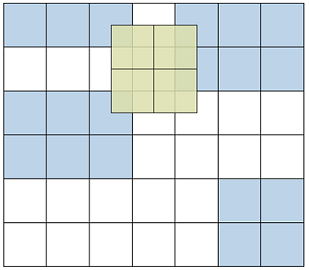Pollution
Atmospheric pollution is the release of harmful material into the atmosphere. The consequences can be devastating – both for humans, animals, plants and the environment itself.
To help identify the source of the pollution in his city, Marko brought a drone that can take precise photographs from high altitudes. His city can be represented as a rectangular grid of the following dimensions: 100 000 * 100 000 meters. Inside the city, there are factories of various sizes, and each of them can be represented with a rectangle.
 |
Marko’s drone takes photographs of width C and height R (1 <= C, R <= 100 000). To help Marko, please write a program that will identify the largest number of factories that can be seen on a photo made by Marko’s drone. A factory is part of the photograph if the area (of the factory) seen on the photograph is larger than 0.
(The rectangles representing the factories, as well as the photos made by Marko’s drone, have sides parallel to the rectangular grid representing the city).
For example, the picture above may represent Marko’s city, with 4 factories on it (colored in light blue). Marko’s drone can take photographs with dimensions 2x2 (C=R=2), and it is possible to take a photograph with 3 factories visible on it (as shown on the picture). Please note that, unlike the factories, the photograph made by Marko’s drone doesn’t necessarily have to start on integer coordinates – however, it’s sides must still be parallel to the rectangular grid representing the city.
Input
The first line contains a single integer number N (1 <= N <= 100 000), the number of factories in Marko’s city. Each of the following N lines contains 4 integers C1, R1, C2, R2, defining two opposite points (C1, R1) and (C2, R2) of the rectangles representing the factories (0 <= C1 < C2 <= 100 000; 0 <= R1 < R2 <= 100 000). No two factories share the same area (their intersection is 0), but they may touch each other (i.e. share a side).
The following line contains two positive integers C and R (1 <= C, R <= 100 000), defining the size of the photographs made by Marko’s drone.
Output
Print the maximum number of factories that can be seen on a photograph made by Marko’s drone, as described in the problem statement.
Constraints
Time limit: 1 second
Memory limit: 256 megabytes
Examples
input 4 5 0 7 2 0 2 3 4 0 5 3 6 4 4 7 6 2 2 | output 3 |
Explanation: Look at the picture shown above, and the description available in the problem statement.
Subtasks
1) In test cases worth 20 points, (1 <= N <= 20)
2) In other test cases worth 8 points, (1 <= N <= 100)
3) In other test cases worth 15 points, (1 <= N <= 500)
4) To earn all 100 points, your solution must work for the input constraints presented in the “Input” section.




